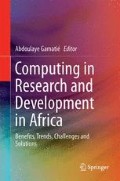Abstract
The biodiversity term refers to the totality of genes, species, and ecosystems of a region or the globe. Biodiversity’s impact on the human health and the ecosystem is without a doubt very significative. Therefore, the conservation of the biodiversity is becoming an international political and scientific issue since it may have a drawback on climate and the human health or survival. For a sustainable development perspective, several ongoing studies are conducted to analyze, predict, and face biodiversity changes. Such studies require a huge volume of data collected, stored, shared, and exploited intensively by researchers through the world by using web technologies and information systems as GEOBON, LifeWacth, GBIF, MosquitoMap. These systems handle an important amount of computing and database resources that must be optimized for avoiding maintaining useless resources while reducing considerably the energy usage. Actually, the goal of such optimization that we propose in this chapter is to adapt (increase or decrease) the number of resources for dealing with data of biodiversity based on the current load (or number of requests) while ensuring good performances. The benefits of doing so are manifold. First, it fits perfectly with the objectives of green computing or green IT that suggest to define computing systems efficiently and effectively with minimal or no impact on the environment. Second, it is well suited for African developing countries that encounter frequently energy problems and that miss enough funds to maintain complex infrastructures.
Access this chapter
Tax calculation will be finalised at checkout
Purchases are for personal use only
References
S.K. Barker, Y. Chi, J.H. Moon et al., “Cut me some slack”: latency-aware live migration for databases, in International Conference on Extending Database Technology (EDBT) (2012), pp. 432–443
Canadian BIF (2013), www.cbif.gc.ca
C. Curino, E.P.C. Jones, Z. Yang et al., Schism: a workload-driven approach to database replication and partitioning. VLDB Endow. 3(1–2) 48–57 (2010)
C. Curino, E.P.C. Jones, S. Madden, Workload-aware database monitoring and consolidation, in International Conference on Management of Data (SIGMOD) (2011), pp. 313–324
S. Das, D. Agrawal, A. El Abbadi, ElasTraS: an elastic transactional data store in the cloud, in International Conference on Hot topics in Cloud Computing (2009)
A.J. Elmore, S. Das, D. Agrawal et al., Zephyr: live migration in shared nothing database for elastic cloud platforms, in International Conference on Management of Data (SIGMOD) (2011)
U.M. Farooq, R. Lui, A. Aboulnaga et al., Elastic scale-out for partition-based database systems, in IEEE International Conference on Data Engineering (ICDE) (2012), pp. 281–288
GBIF France (2013), www.gbif.fr
GBIF Secretary: GBIF data portal, GBIF web site (2013), data.gbif.org
GEOBON Web site (2013), www.earthobservations.org
I. Gueye, I. Sarr, H. Naacke, TransElas: elastic transaction monitoring for Web2.0 applications, in Data Management in Cloud, Grid and P2P Systems (2012), pp. 1–12
I. Gueye, I. Sarr, H. Naacke, Exploiting the social structure of online media to face transient heavy workload. In The Sixth Intl. Conf. on Advances in Databases, Knowledge, and Data Applications, IARIA (2014), pp. 51–58
LifeWatch Web Site (2013), www.lifewatch.com
Map of Life (2013), www.mappinglife.org
MosquitoMap (2014), www.mosquitomap.org
A. Quamar, K. Ashwin, A. Deshpande, SWORD: scalable workload-aware data placement for transactional workloads, in International Conference on Extending Database Technology (EDBT) (2013)
J. Schaffner, T. Januschowski, M. Kercher et al., RTP: robust tenant placement for elastic in-memory database clusters, in International Conference on Management of Data (SIGMOD) (2013), pp. 773–784
The Convention on Biological Diversity (2013), http://www.cbd.int/
A. Thomson, T. Diamond, S. Weng et al., Calvin: fast distributed transactions for partitioned database systems, in SIGMOD (2012)
Author information
Authors and Affiliations
Corresponding author
Editor information
Editors and Affiliations
Rights and permissions
Copyright information
© 2015 Springer International Publishing Switzerland
About this chapter
Cite this chapter
Sarr, I., Naacke, H., Bame, N., Gueye, I., Ndiaye, S. (2015). Green and Distributed Architecture for Managing Big Data of Biodiversity. In: Gamatié, A. (eds) Computing in Research and Development in Africa. Springer, Cham. https://doi.org/10.1007/978-3-319-08239-4_2
Download citation
DOI: https://doi.org/10.1007/978-3-319-08239-4_2
Published:
Publisher Name: Springer, Cham
Print ISBN: 978-3-319-08238-7
Online ISBN: 978-3-319-08239-4
eBook Packages: EngineeringEngineering (R0)

